Writing and publishing a book can feel like a monsterous task, especially if you're not used to delivering such huge projects. But despair not, in today's encore post, John Wagner-Stafford, co-founder of ALLi Partner Member Ingenium Books, explains how to do this super-efficiently by designing and following your own book project plan.

John Wagner-Stafford talks you through the steps of creating a book project plan
A project plan for your book serves the same purpose as the blueprints for the house you'll build, the trip plan for your year-long round-the-world trip, or the grocery list for your big dinner party. It begins with an idea of what you want to achieve and ends with the last tasks needed to successfully publish your book.
At Ingenium Books, we believe that writing a book and self-publishing in today’s marketplace requires adopting some good small business practices. If you approach your book writing and author career like a small business owner, you will increase your chances for success.
Most businesses today pay special attention to how they plan their projects. They employ at least a few project management best practices and some sort of a project management system. The general notion of winging it without a plan will probably not get you very far when running your own business, including when that business involves publishing your own book.
What is a project plan for your book?
Essentially, a book project plan is a status gathering and reporting system.
An example
When I worked at Ubisoft as a video game producer and the world entered into a new millennium in 2000, I and my team were huddled around one of our open-space meeting tables setting up and planning a new project: Prince of Persia, The Sands of Time. We faced many decisions and choices about technology, systems, people, and money. My responsibility was to sort out how we were going to report our progress. Which data gathering and reporting system we would use to plan, track and report the progress and health of this enormous project? Ubisoft wanted to make sure each project manager, all the creative leads, the game designers, story writers, and the producer (me) were all on the same page. I chose a combination of Microsoft Project for the big picture and a system I developed for the daily deliverables.
The systems would need a project manager who would enter and update the data daily to help us manage dependencies and resources. We would literally do the rounds with each artist and enter into the database the percent of their progress, take note of any anomalies or roadblocks in the way of advancement, then the report would end up on my desk each afternoon, so I would be able to decide how to move forward with the next day's plan.
Your book project plan
You can use these principles and concepts for your book project too. There won't be quite so many moving parts and there will be fewer people to deal with.
A book project plan can be a simple task list on a piece of paper, several pieces of paper in a file folder, or a plan created with a software program. Either way, it will have some or all of these characteristics:
- May be laid out on a timeline indicating when tasks are to be completed, how they relate to each other, and what happens if they are delayed.
- Provides a view of how long it will take to get the job done.
- Offers a window into how much your project will cost.
- Gathers together in one place all the information you need to answer the questions: why, what, when, who, and how.
- Answers the question, what if? Your plan will allow you to test different scenarios and help you choose which one is right for any moment.
A plan makes it easier to turn on a dime and head in a different direction.
Without a plan, you will not see problems on the horizon which are slowing you down now.
And you will have no effective way to course correct when things are not quite right.
Benefits of a book project plan
Most authors come to us with an idea, or a manuscript of varying quality, in various stages of completion. They don't, however arrive with plans. They often haven't thought of a marketing plan, or a distribution plan. Not one has ever considered a book project plan. Well, we think of—and take care of—the book project plan.
Writing a plan is the first step to organizing your project. It delivers a fighting chance for your book to get published the way you conceived it.
It helps you identify, in advance, all the very components that go into writing and publishing your own book. A book project plan focuses on getting the important things done at the right time and it helps you choose priorities.
Your plan will let you see which tasks are falling behind or which one need to be advanced. It lets you see what happens to your scheduled publish date if things get delayed. (Like maybe completing the first draft of your manuscript is taking you way longer than you expected. It happens.)
Creating your book project plan will help relieve the burden of constantly wondering if you're on top of every detail. It will let you focus on the big picture.
How do you put a book project plan together?
You'll need to do a bit of research, and it will take a bit of time to get it all set up right. Here are some high-level project plan components you can start with to get you going.
- A plan/purpose statement
- Big-picture task list with estimated durations and dependencies (what other tasks are dependent on this one)
- Resources list
- Deliverables list and their costs
- Timeline (could be Excel or Numbers, at Ingenium Books we use Aeon)
- A project purpose statement
Your purpose statement includes why you are writing your book. It will address what you expect to gain personally and professionally as a result of writing your book and what are you able and willing to invest to get your book published (time and money).
If you have already created a purpose statement, add it to your book project plan. You will be reminded of your purpose each time you update your plan. When you hit a rough patch, or become overwhelmed, having your purpose statement right up front on your book project plan will help you answer the question, “Why am doing this, and why now?”
- Big-picture task list
What you add to your task list will depend on what stage you are at in getting your book published. Your task list could also be affected by the subject and genre of your book. If you have a lot of writing to do to finish the first draft of your manuscript, you might break down your writing tasks by chapter. It will also depend a bit on what help you are planning to obtain from others:
- Are you hiring a cover designer?
- Editor?
- Marketing specialist?
If you have a lot of research to do, for example, that might make its way onto the task list.
In general, though, the big-picture tasks will be similar for most authors and most books. Here is an example of a partial list of starting-point tasks we add to our plans to get your book published:
✓ Project start
✓ Project purpose
✓ Marketing plan
✓ Manuscript development
✓ Marketing implementation
✓ Distribution prep
✓ Pre-Launch marketing
✓ Launch week
✓ Post-launch marketing
Of course, under any of these high-level tasks, you will need to add subtasks. Adding these subtasks to the project plan for your book has pro and con implications, in particular related to manageability and clarity.
With more detail comes more effort. There will be more follow up and more reporting, BUT you are less apt to miss out on the little things.
With less detail, the process is much easier to manage, follow, and report on. But you might miss something important.
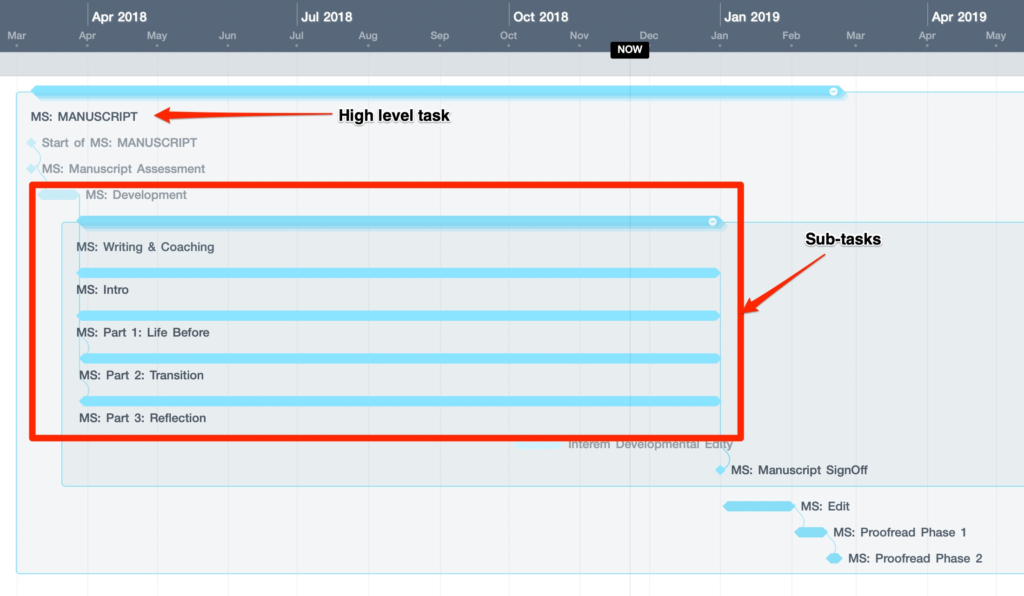
- Resources list
Simple and easy. This is where you identify who will be doing what. You can do this in one of two ways. Use titles, or use people's names. We use titles like author, cover designer, editor, proofreader, formatter, etc. If yours is a simple plan and you are doing most of the work yourself, then you might not need this. (A word of advice though, never underestimate the need for an editor. If you hire no one else to help with your book, at least hire an editor!)
- Deliverables list
Adding a deliverables list is essential. It does not need to be exhaustive but will help when you are identifying dependencies. Assigning dependencies will help to realize the impact of early or late delivery on other tasks or deliverables, such as your launch date.
Record the deliverable and who will be responsible for the delivery. Determine the duration, the cost, and what task(s) need to be finished before this can start and which task(s) cannot start until it is delivered. The result of adding deliverables to your project timeline might look like this in your plan.
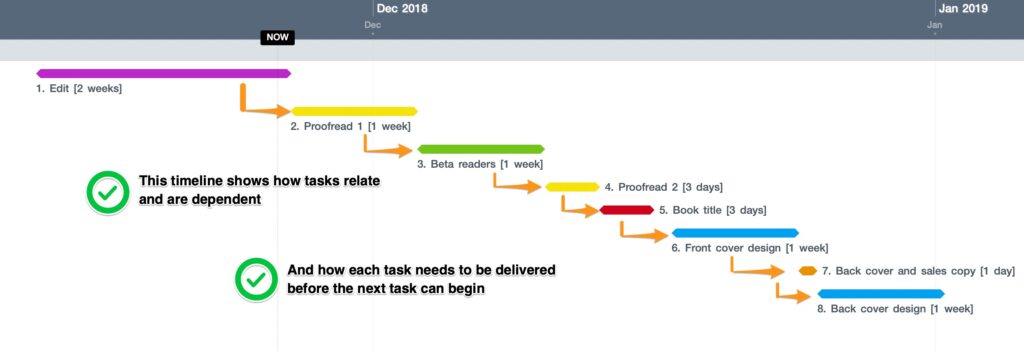
- Project timeline
The project timeline is part of the system and can take on one of many forms. It can be as simple as your Outlook or Google calendar. You can use an Excel spreadsheet or sophisticated gantt chart software. The important notion is to create a view of the progression of each task and how it relates to time passing, when it should be completed, and the order in relation to the other tasks. As your project progresses, modify the dates or position in your system to give you a view of how the changes affect what is to come. Here are a few examples:
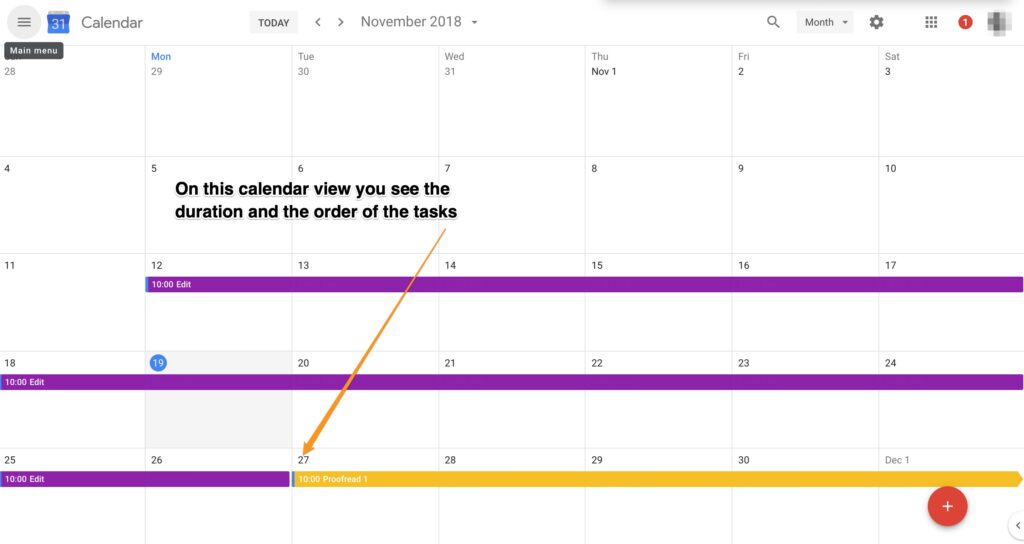
Google Calendar

Excel spreadsheet
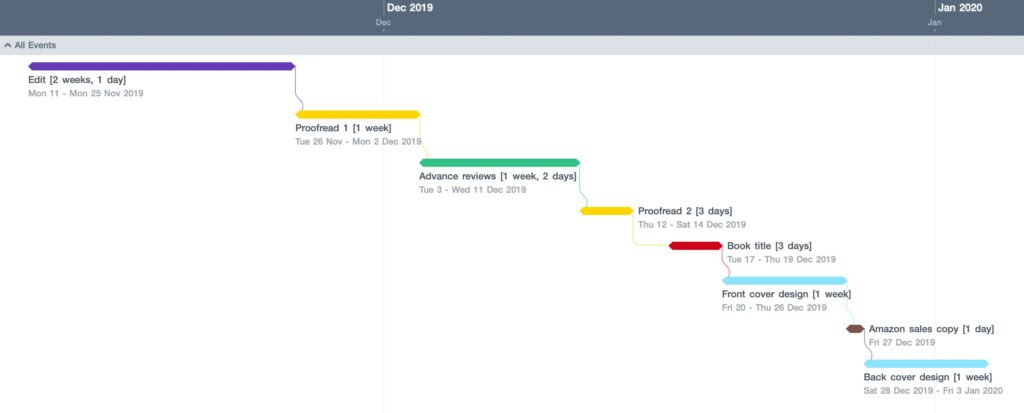
Gantt chart
Conclusion
By preparing a book project plan you will provide yourself with:
- an effective means to monitor how your project is advancing
- a view of which tasks are not panning out as planned
- what effect that might have on the overall project
It will help you better manage your book project in a professional, business-like manner.
And, approaching your book project with a small-business perspective will pay off in spades by saving time and money. Also, you’ll appear to be organized and professional in the eyes of your suppliers and it will boost your own confidence about getting your book published. Period.
John is co-founder of Ingenium Books, which is a partner member of ALLi. He’s also a serial entrepreneur and a creative project producer. John’s creative & entrepreneur accomplishments include professional musician (saxophone, vocals); recording engineer with artists like Peter Frampton, Celine Dion, Pat Metheny, and Leonard Cohen; soundtrack producer for film and television; trainer and coach to the sound mixer team at MSNBC when the New York-based network went live for the first time in 1997; producer of notable video games such as Prince of Persia, Myst IV-Revelation, and Splinter Cell IV-Double Agent; COO during the startup phase for KANDY Outdoor Flooring Inc., licensed realtor in two Canadian provinces; a master canoeist; and ASA-certified sailor. John is co-author, with his wife and business partner Boni Wagner-Stafford, of Rock Your Business: 26 Essential Lessons to Start, Run, and Grow Your New Business From the Ground Up.
OVER TO YOU Do you have any further ideas to add to John's advice? We'd love to hear them.
How to use a book project plan to manage the production of your self-published book - by John Wagner-Stafford of @IngeniumBooks #selfpublishing #indieauthors Share on XOTHER USEFUL POSTS ABOUT BOOK PRODUCTION
From the ALLi Author Advice Center Archive

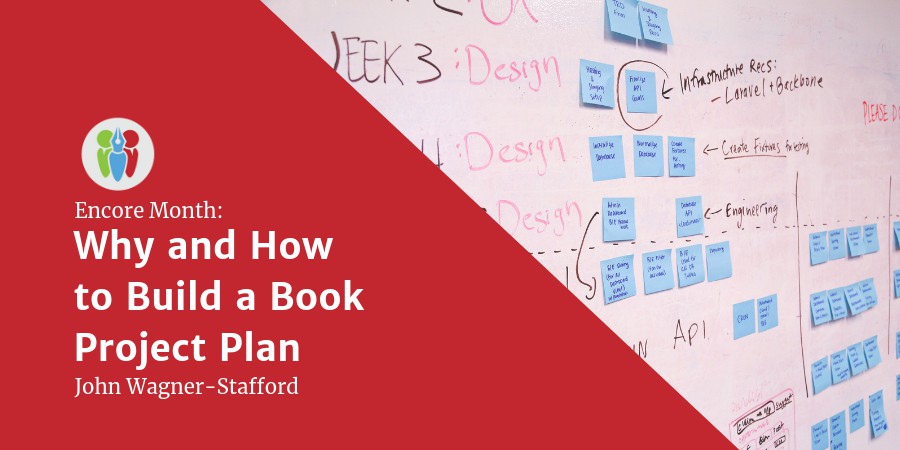



Just a heads up that the ingenium link on this page doesn’t work. Looks like a problem with www vs no www on the domain.